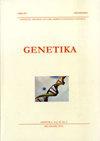利用SSR标记对红花(Carthamus tinctorius L.)基因型的遗传多样性进行了研究
4区 农林科学
Q3 Agricultural and Biological Sciences
引用次数: 0
摘要
红花是世界上一种富含不饱和脂肪酸的健康食用油的一年生油籽作物。本研究利用10个SSR位点对土耳其红花注册品种(4个)、美国农业部(USDA)检索到的基因型(10个)及其杂交品种(45个)进行遗传变异分析。遗传多样性计算结果为:平均等位基因数(4.67),期望杂合度(0.680),平均有效等位基因数(3.172),多态性信息含量(0.664)。树状图分析显示亲本和杂交种中至少有四个可能的主要簇。居群间遗传多样性较高,Fst计算值为0.593,表明聚类之间存在分化。土耳其注册的红花品种分布在所有4个集群中,大部分集群定义了来自美国的品种。基于树状图的方法分析显示有刺红花和无刺红花基因型有两个主要的聚类。结果表明,这6个SSR标记可用于红花育种研究。本文章由计算机程序翻译,如有差异,请以英文原文为准。
The genetic diversity of safflower (Carthamus tinctorius L.) genotypes developed by hybridization using SSR markers
Safflower is an annual oilseed crop which has healthy edible oil containing high amount of unsaturated fatty acids in the world. In this study, we investigated safflower registered cultivars of Turkey (4), genotypes retrieved from USDA (10) and their hybrids (45) for genetic variation using 10 simple sequence repeat (SSR) loci. Genetic diversity calculated registered cultivars, genotypes and hybrids were as follows: mean number of alleles (4.67), expected heterozygosity (0.680), average effective number of alleles (3.172), and polymorphism information content (0.664). The dendrogram analysis revealed at least four possible major clusters in the parents and hybrids. High level of genetic diversity explained between the populations and Fst calculate (0.593) suggested that the clusters were differentiated to each other. Registered safflower cultivars of Turkey were distributed across all four clusters and the accessions from USA were defined in most of the clusters. The dendrogram based method analysis revealed two major clusters which corresponded to spiny and spineless safflower genotypes. It was suggested that the studied 6 SSR markers could be utilized for safflower breeding studies based on molecular analysis.
求助全文
通过发布文献求助,成功后即可免费获取论文全文。
去求助
来源期刊

Genetika-Belgrade
AGRONOMY-GENETICS & HEREDITY
CiteScore
1.80
自引率
0.00%
发文量
1
审稿时长
6-12 weeks
期刊介绍:
The GENETIKA is dedicated to genetic studies of all organisms including genetics of microorganisms, plant genetics, animal genetics, human genetics, molecular genetics, genomics, functional genomics, plant and animal breeding, population and evolutionary genetics, mutagenesis and genotoxicology and biotechnology.
 求助内容:
求助内容: 应助结果提醒方式:
应助结果提醒方式:


